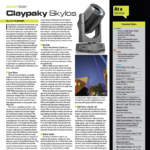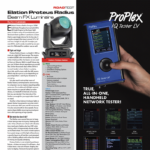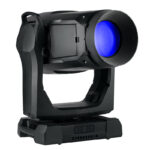It was just a few months ago that I was looking at the spot version of this light, the Scenius Spot (PLSN, March 2016, page 62). It impressed me then; Clay-Paky is known for their high quality fixtures, and this one was no exception, with excellent dimming and color mixing. This time, we look at the Profile version of the Scenius, intended to fill a role needing additional beam control and shaping — particularly useful in theatrical contexts, or as front lighting for actors and scenery.
The Scenius Profile shares the same lamp and exterior form factor with its Spot cousin, with a 1400W lamp from parent company Osram with a native color temperature of 6000K. To change the lamp, users loosen four captive screws at the rear of the head, remove the cover and twist out the lamp, inserting a new one. All parts remain captive during installation so there should be no problem with changing a lamp while hanging. The light comes with a reflector specifically designed to produce an extremely even and flat field, and it succeeds — it produced a very smooth field all along the entire zoom range, and I saw no visible hotspots. What is also noticeable with the new reflector is the increased CRI this fixture has attained. The high CRI falls between 91-95, producing a very crisp white beam.
Dimming and Movement
Immediately after the lamp, reflector and hot mirror are a pair of dimmer flags. These are of a design I’ve seen before in Clay Paky lights — a pair of metal flags with a comb-like edge, on top of which sits frosted glass to help smooth out the edges. The flags work well; the dimming very closely follows an ideal square law curve, and it was almost perfectly even across the field, with no visible vignetting.
Pan and tilt ranges 540º and 268º respectively. A full-range pan rotation took 4.9 seconds and full-range tilt took 3.2 seconds. There is a “fast” setting in the menu system that speeds both of these up a bit. Pan and tilt locks are provided for transport. I found the tilt lock somewhat fiddly and difficult to engage and disengage.
Color and Gobos
The next module in line is the color module. The color mixing system consists of four pairs of glass flags that open and close like curtains by running back and forth on a pair of tracks. Cyan, magenta, and yellow color flags are here, and they all work as expected. As in the Spot version, there is a variable CTO filter, which takes the CCT of the output down to around 2700K. While the spectral characteristics of arc lamps make it essentially impossible to make this output a perfect match for an incandescent lamp, the quality here is nonetheless quite flattering to skin tones.
Like all hard-edged fixtures with variable focus, there are better and worse positions in which to have your focus if you want an evenly-colored beam. For instance, there are some slightly unevenly-colored edges present when you focus on the gobo wheels, but this is a characteristic common to all optical systems of this sort. In comparison to other lights of this class the evenness is quite good, and I suspect that the module’s position in the optical train is partly responsible for this. In short, this is a very usable color mix system.
Gobos and fixed colors are on a separate module after the color module. The very fast fixed color wheel consists of seven trapezoidal dichroic filters on a wheel plus open, which are glued in place and therefore are not user-replaceable. Gaps between adjacent filters are very small, producing very usable split colors. The included colors are chosen to complement the mix system, including (among others) a deep amber, saturated red and a Congo blue. I found the split red and amber, in particular, to be a pleasing color combination.
Gobos are also on this module, one rotating wheel with six patterns plus open and a fixed gobo wheel with eight plus open. The rotating patterns include a good mixture of aerial and pattern projection, while the fixed patterns lean toward breakups for projecting onto scenery. All gobos on both wheels use the familiar slot and lock system and are user-replaceable. Rotation is very smooth down to the slowest speeds. The 16-blade iris is also here, which smoothly reduces the beam aperture, and also has macros for easy programming.
The Profile leaves an additional rotating gobo wheel and an animation system out in lieu of a four-bladed beam shaper. Each blade can be inserted across the entire output. Each also rotates, providing flexibility to create shapes like triangles. I measured a full blade insertion at 0.72 seconds. The module also rotates 90º within the light, taking one second to make a full-range movement. Each blade is on a slightly different focal plane, and it is therefore impossible to get every single blade into perfect focus, but one can get quite close. I suspect many users of this light will use this system with the blades out of focus, like a theatrical ellipsoidal, so I didn’t find this objectionable.
Next in line is the optical system, including the moving lens elements, the two frost filters and the four-facet prism. The frost filters are interesting — they are controlled by one channel, so when the frost channel reaches a DMX value of 128, the second filter moves in over the first. The first is a subtle filter that diffuses the edges of gobos but still allows the pattern to come through, while the second is a heavy frost filter that essentially turns the output into a wash. Prism insertion is reasonably fast and provides good image separation, though it can accentuate unevenly-colored beams with half-mixed colors.
Zoom is very fast and covers a wide range, from 8º to 50º. Focus tracking works reasonably well, however the zoom travel range is greater than the focus travel range. Therefore, at the narrowest zoom ranges, you cannot get gobos into focus. Clay Paky prioritized a greater zoom range over making sure both ranges overlapped perfectly, and it’s just something to be aware of in your programming.
Serviceability
The modular nature of this light should make servicing very easy. All screws on the body remain captive when removed, and Clay Paky has gone the extra mile in designing a safety attachment system for the exterior covers that isn’t a pain to use. Instead of a tiny fiddly carabiner or a screw that has to be loosened, the safety cable ends in a small cylinder-shaped “key” that easily locks and unlocks in a small receptacle. This is something that I dislike on many lights — the safeties for the head covers are on very short cables and often very difficult to remove. The system here is extremely convenient.
The modules themselves are easy to remove as well, with the screws remaining captive and guides to hold everything in the correct place. These little details show the commitment to quality that Clay Paky is known for, and demonstrate that they think about the entire personnel chain.
The fixture weighs 87 pounds (39.5kg) and accepts power via Neutrik PowerCON True1, and auto-ranges from 200-240V. Rigging hardware is industry standard quarter-turn Omega-style brackets. The fixture accepts DMX via a 5-pin connector, or Art-Net through an onboard Ethernet port.
At a Glance
Ready to Shine
The Scenius Profile is another in a long line of high-quality offerings from Clay Paky. Like the Scenius Spot, the Scenius Profile brings an impressive array of features and functions particularly well suited to the needs of designers looking for additional beam control and shaping. Particularly useful for theatrical applications, this fixture can also benefit any production that needs high-quality front or scenic lighting.
Clay Paky Scenius Profile
- PROS: Flat, smooth output, smooth color mixing
- CONS: None
FEATURES
- 1400W Osram discharge lamp
- Optical reflector for uniform beam projections
- Framing System operating on 4 focal planes
- Framing System rotation on 90°
- Focus Tracking System
- 6500K Output Color Temperature
- Very High CRI
- CMY System + Linear CTO
- 7-Color Wheel
- 14 Gobos (6 rotating + 8 fixed)
- Rotating Prism
- 16 Blade Iris
- Variable “Soft Edge” Frost
- Variable Flood Frost
- 0-100% Dimmer
- Fast Stop/Strobe Effect
- Light can be Run at 1400W or 1200W
- Art-Net/RDM
- Quiet, Reliable and Road-Ready
STATS
- Zoom: 8°-50°
- Pan/Tilt: 540°/268°
- Size: 16.14” x 14.17” (base); 30” (H)
- Weight: 87 pounds
- MSRP: $16,330
- Manufacturer: Clay Paky
- More Info: www.claypaky.it



